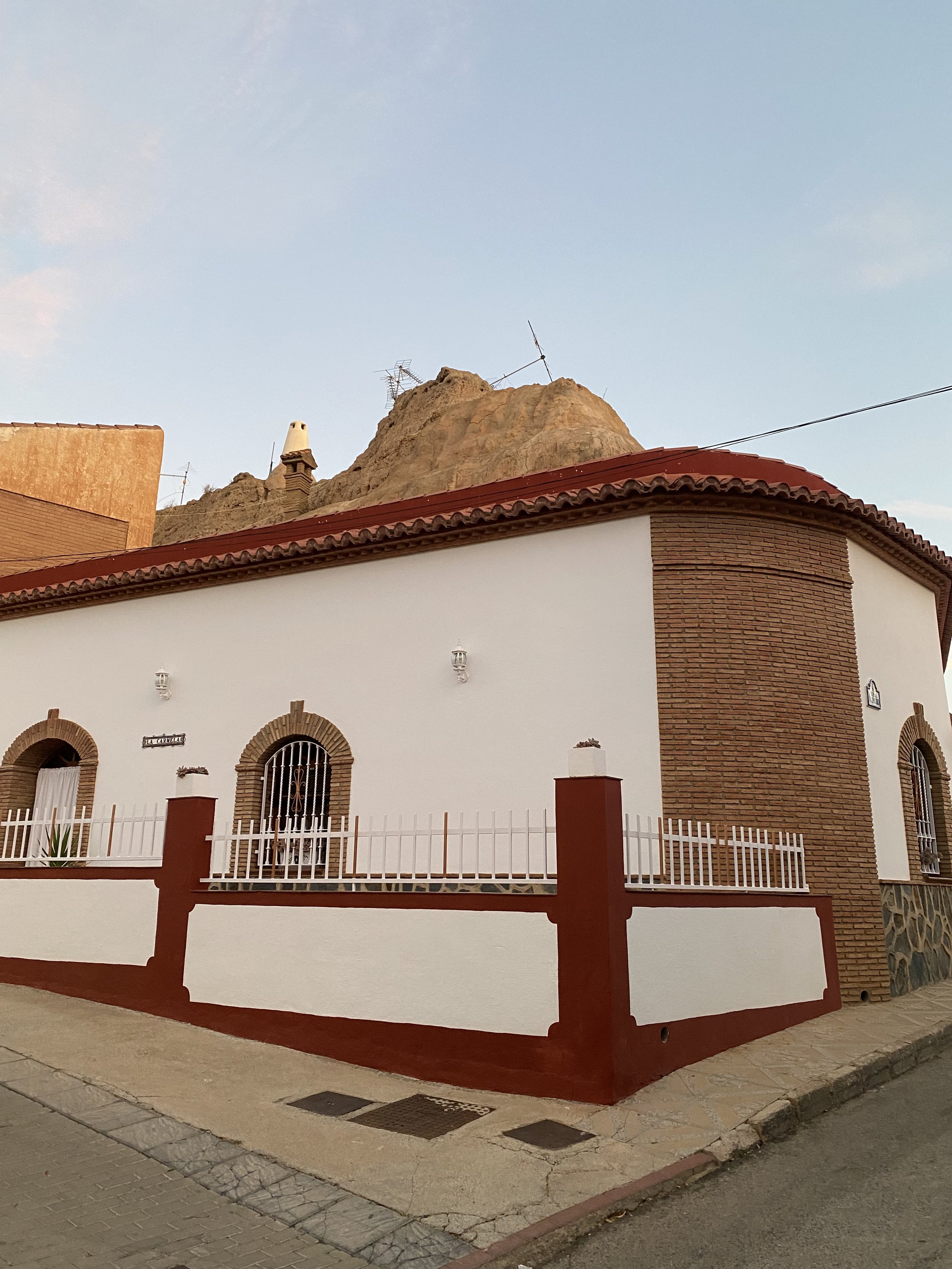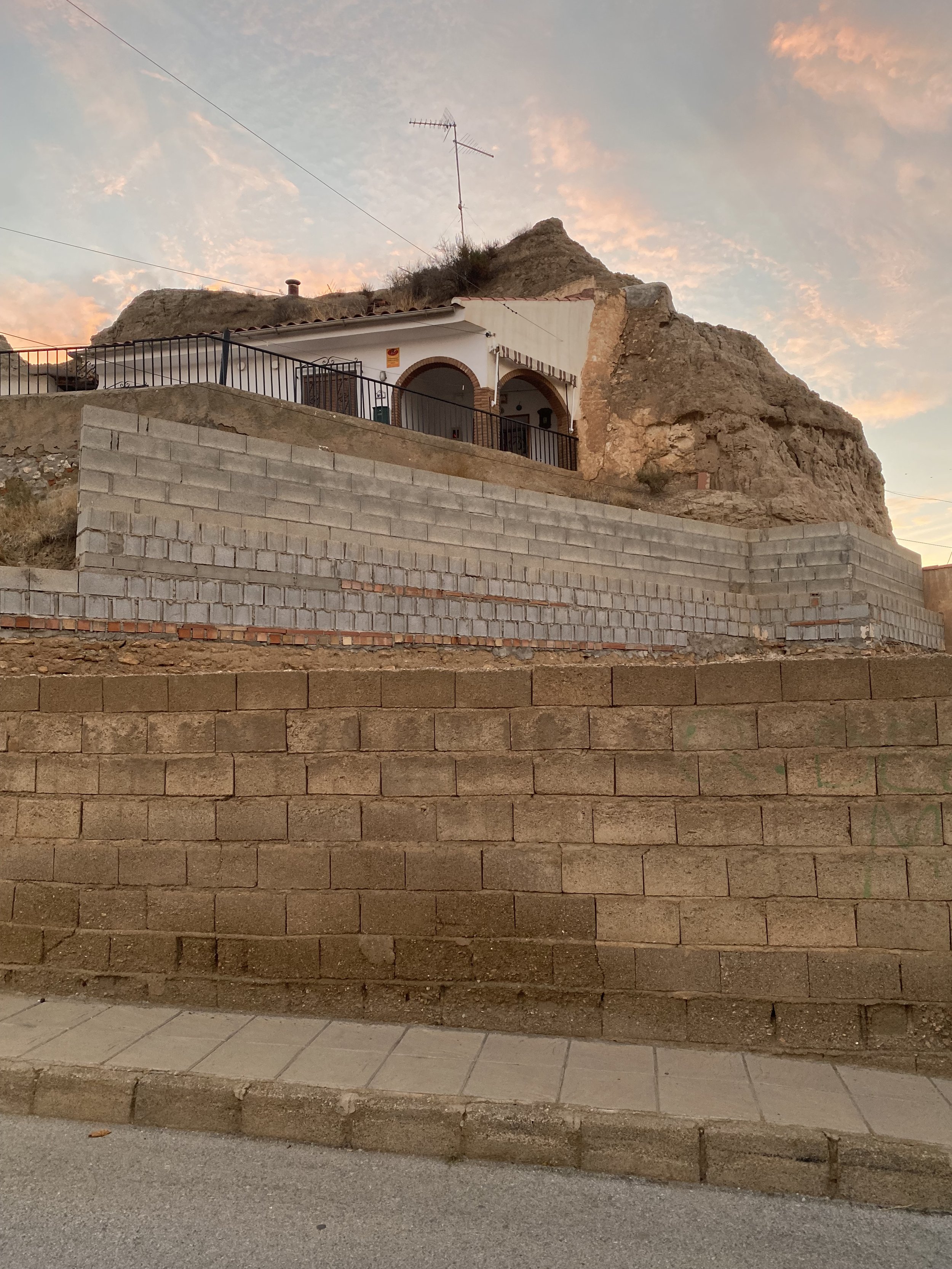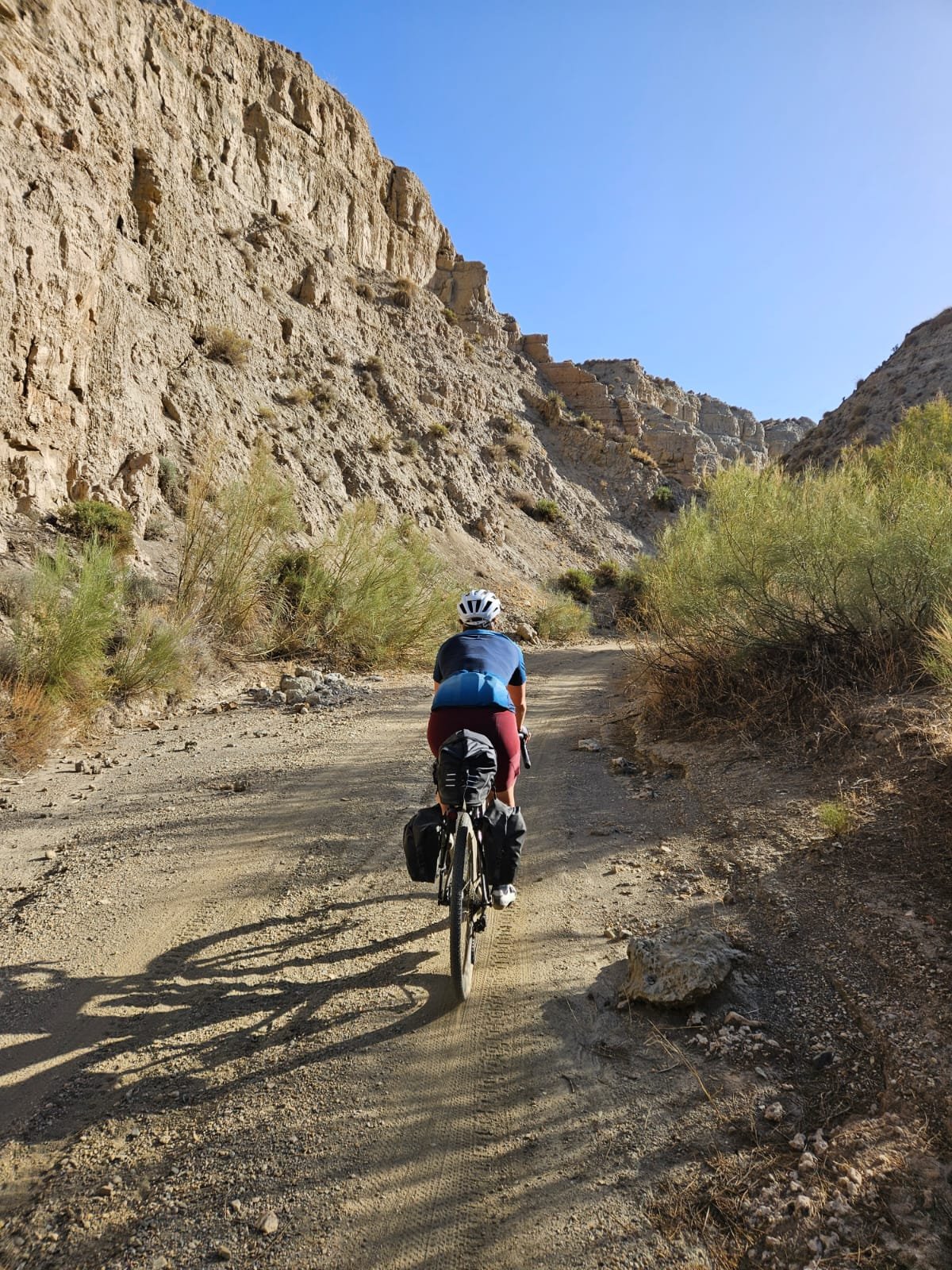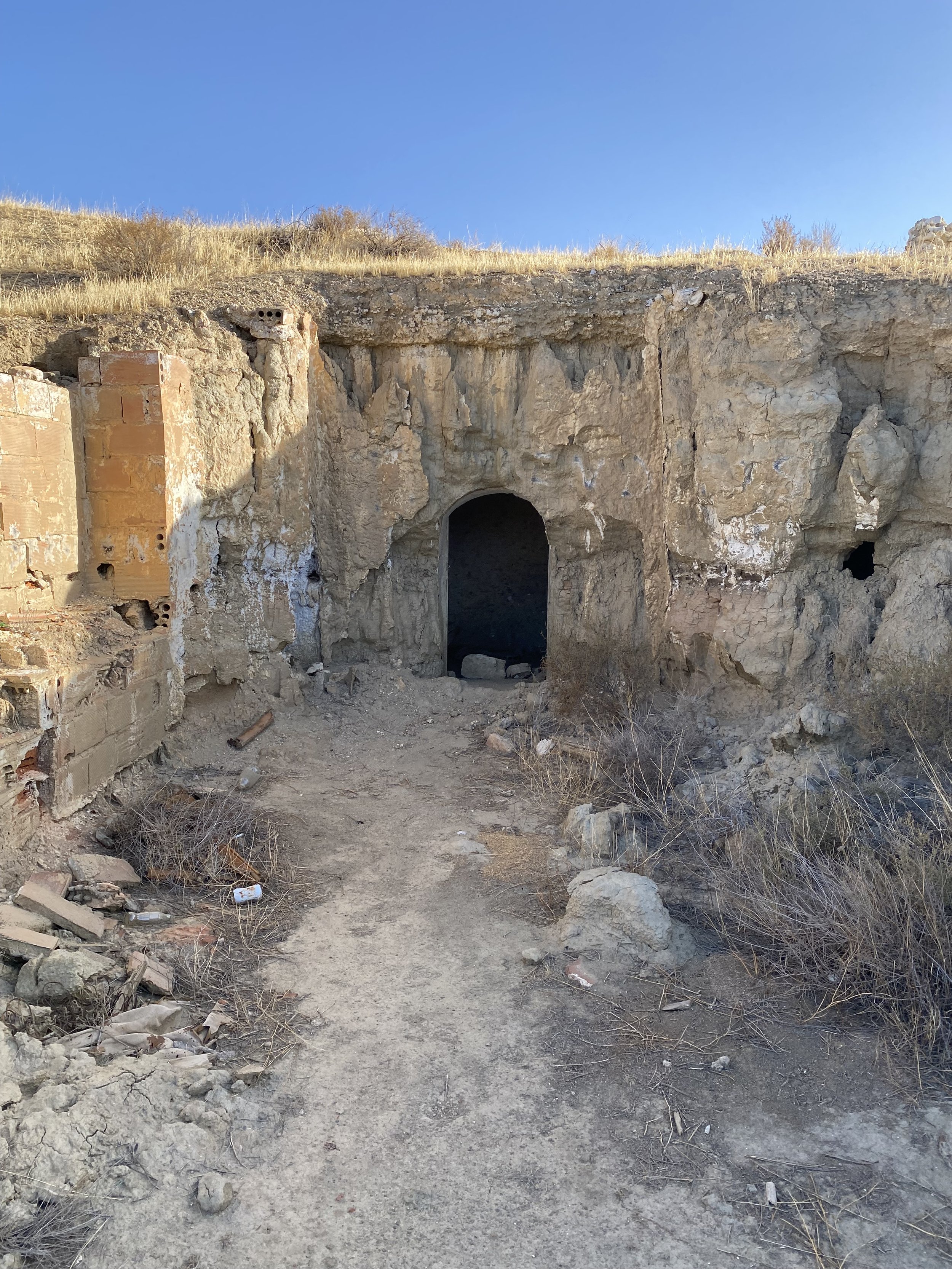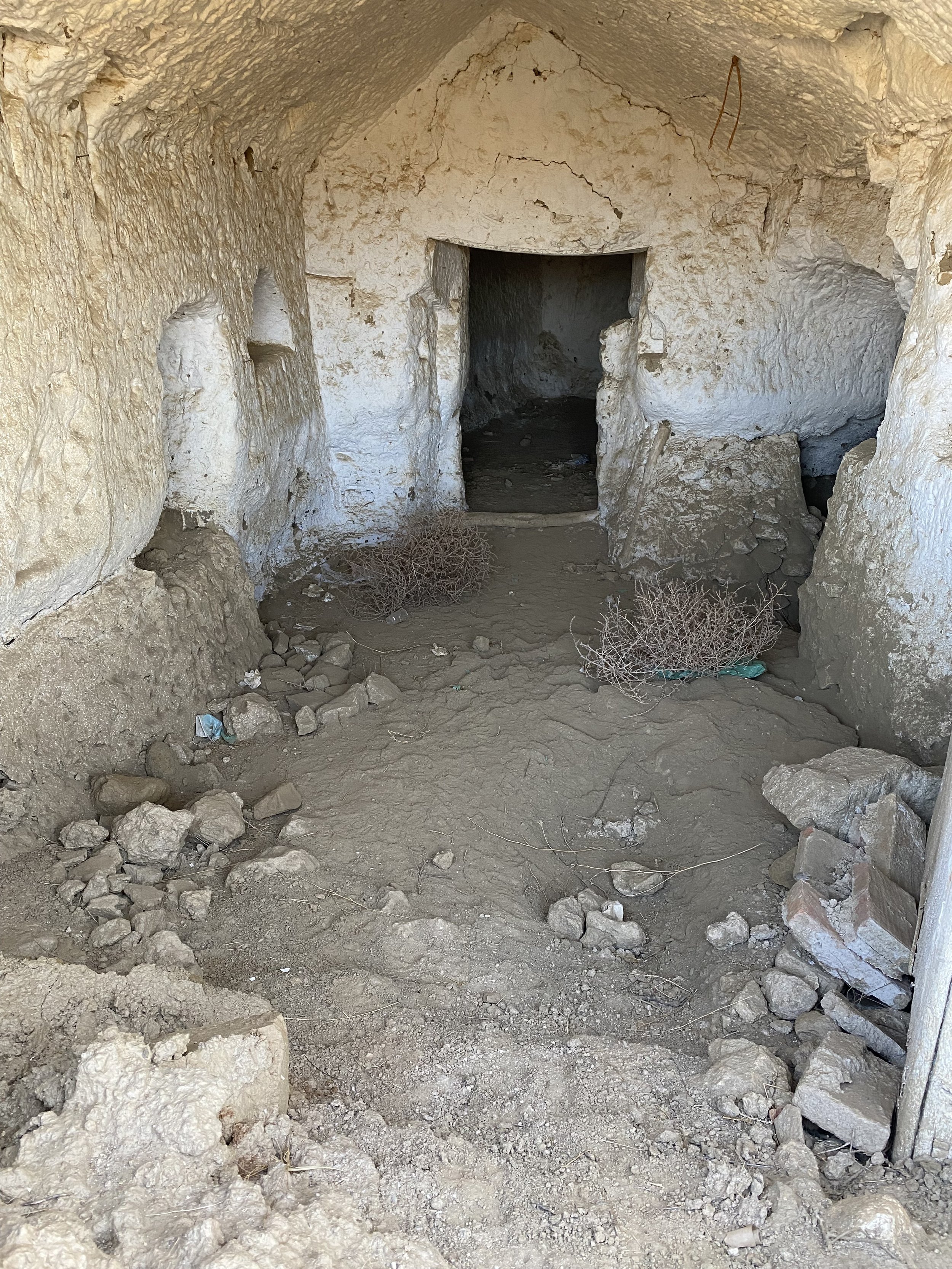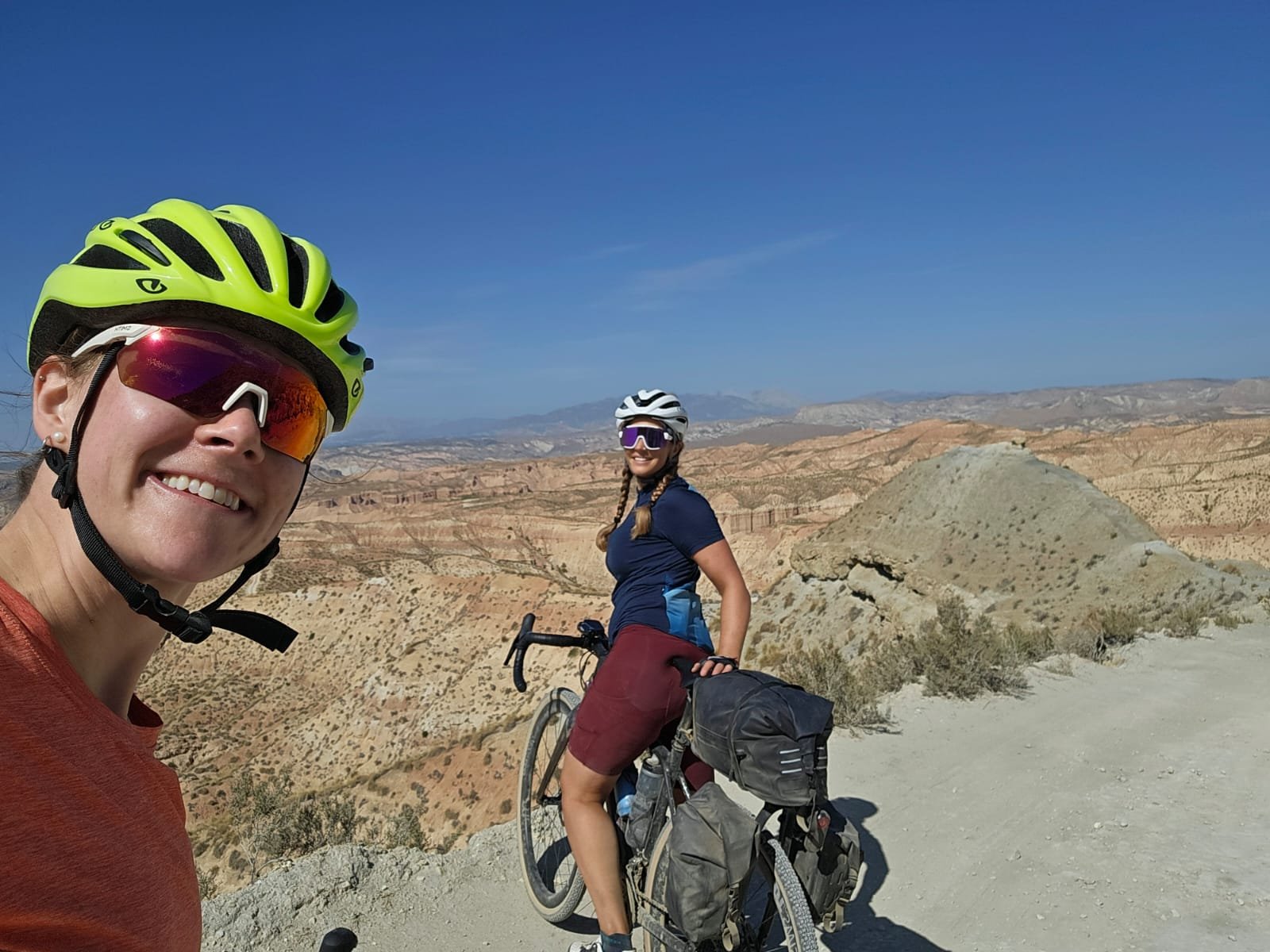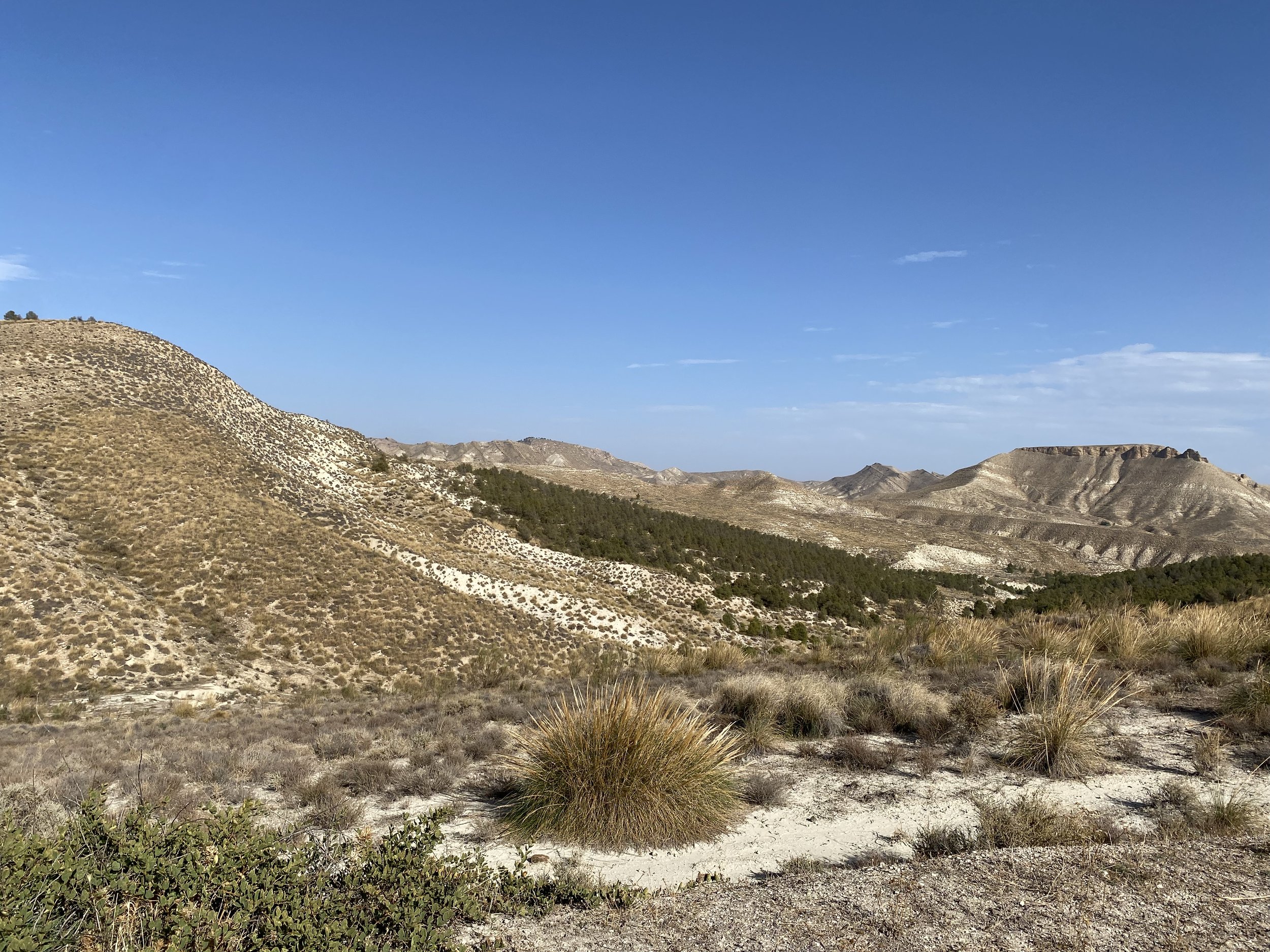Day 2 - Benalua to Hinojares: bikepacking the South of Spain
Destination: Hinojares - Distance: 108km, elevation gain: 1862m, surface: 75% unpaved
*If you missed Day 1, you can read it here.
It’s Sunday in the south of Spain, the Christian Sabbath. Properly observed, this means a day of rest and time with family, so local businesses are customarily closed. Foreseeing this as our most challenging day to find food, we deliberately spent time planning out our nutrition during the previous night’s dinner. The industrial sized espresso machine was a promising indicator, so I used our translation app to ask if the restaurant was open for breakfast. Our server told us no, they were not open for breakfast, but there was a place around the corner open at 6am. “Six?” I asked, holding up six fingers to emphasize my point. “Si.” As doubtful as 6am sounded, the prospect of getting rolling a bit earlier was sufficiently tempting. Despite Jocelyne (Care Bear) and I both possessing a natural affinity to unquestionably accept a well intentioned a message, there was something that felt a little improbable about the aforementioned small town Spanish restaurant being open for 6am on a Sunday, so to be conservative, I SET MY ALARM (lessons learned from Day 1) for 7am. We could be packed up and heading for breakfast by 8am. Surely a two hour buffer is enough time to ensure they’ll be open, even on Sunday, even in Spain.
Our 7am wake up call hurt. We both slept terribly, overheating as our bodies figured out how to process the experiences we had just subjected them to. We were drained physically, dehydrated, and we botched all attempts to consume adequate electrolytes. Jet lag remainded a real problem. It was going to be a rough day. What I needed more than anything in the world at that moment was a stiff Spanish coffee. Yes, this was definitely the answer. Caffeine would fix everything.
We hastily locked up our hotel and practically skipped over to the breakfast place, giddy with anticipation of a hot meal and a strong coffee, only to find it closed. NOOOOOOOOOOO!!!! Fourchette. Not a soul in sight. In fact, there wasn’t a single door or window open on the entire street. It was actually quite remarkable, like we awoke to the aftermath of a vampire apocalypse (why specifically vampires you may ask? Why not zombies? Presumably during a zombie apocalypse there would at least be some zombies wondering around the streets, the vampires would be safely back in their coffins by now. It was after sunrise, already 8 am, and not a soul in sight, living or undead. But back to my disheartening lack of coffee). Alright let’s regroup. We’re two smart people. What are we missing? Maybe the server last night meant 9am not 6am. That sounds more culturally appropriate and those two numbers could be easily confused, right? They look sort of similar if you’re a little drunk. We decided to go for a walk and check out the town and wait to see if things opened up at nine.
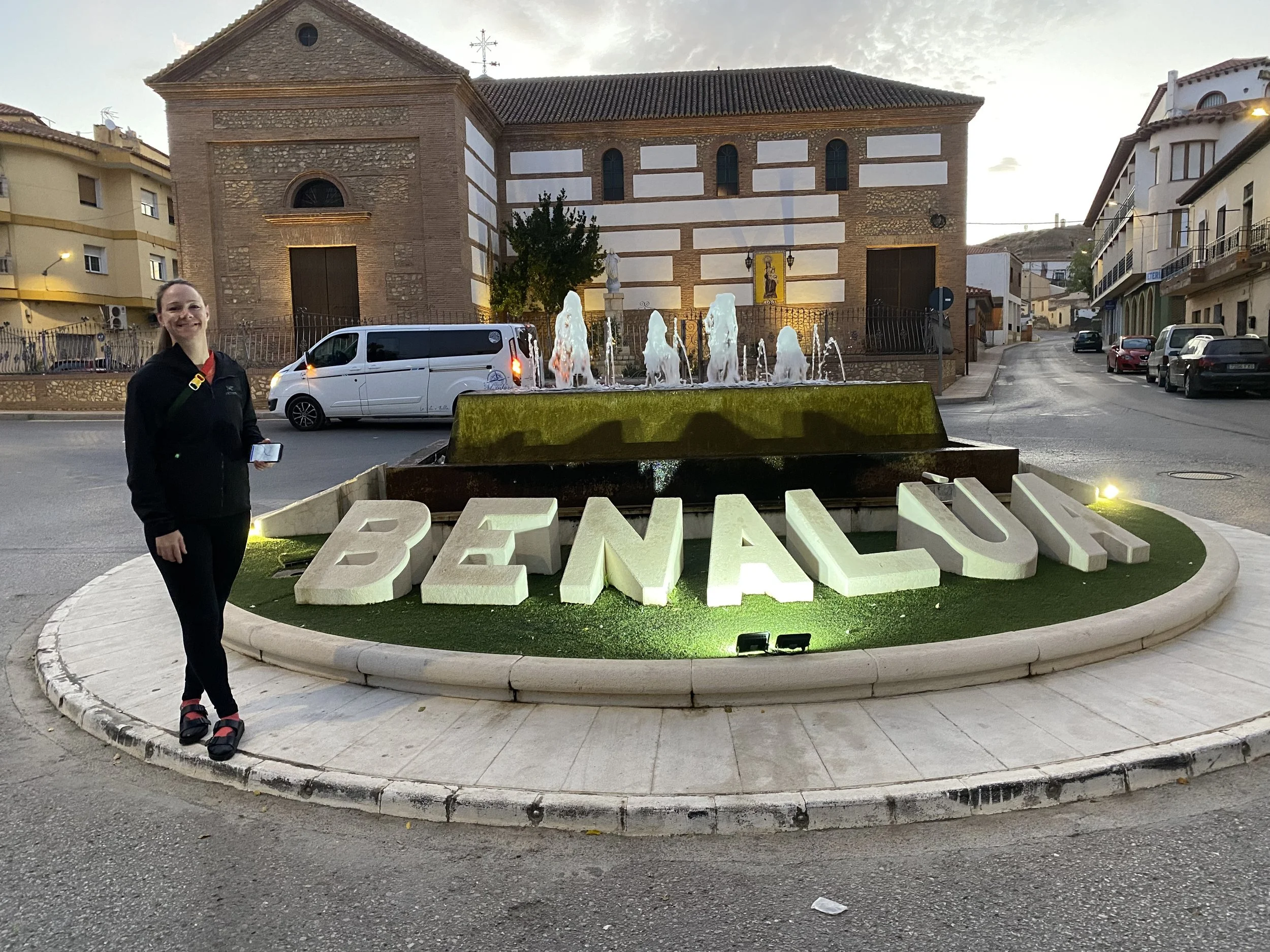
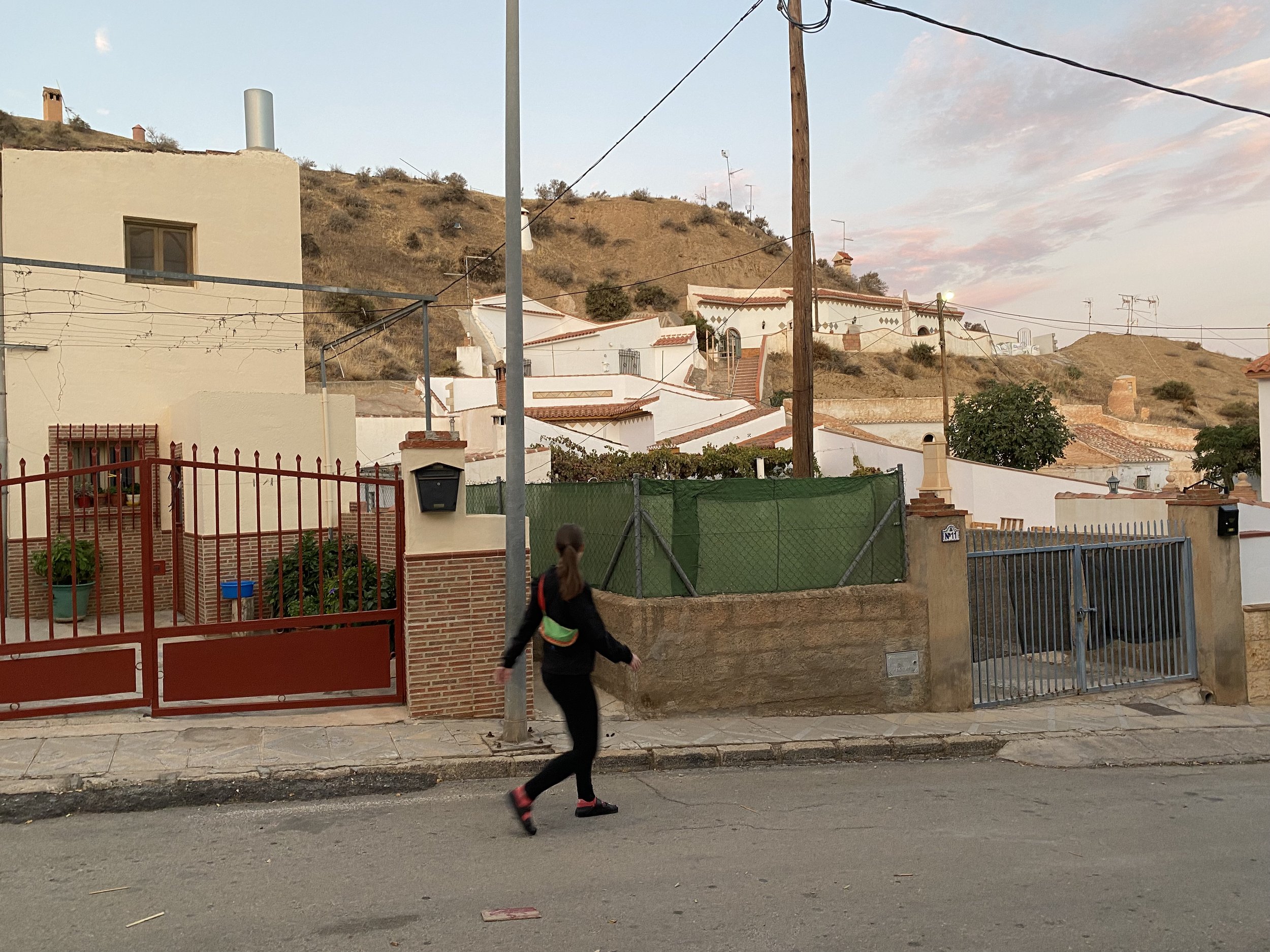
Things did not open up at nine. Not a single business. Though we did enjoy our walk around the town. It was pretty, with a lot of homes embracing the region’s architectural heritage by incorporating caves into their design. Several cultures uphold this style of prehistoric inhabitance, it being both safe and practical. The Moors are one of them so it is remarkably prevalent in the region.
This little impromptu tour didn’t, however, make up for us still being without breakfast or coffee. We Googled our options, but the prospects were grim. Two spots were in theory open, but in practice were not (we were slowly comprehending the level of importance Spanish culture places in their Google business hours accurately reflecting an actual presence in the building). My last bit of hope for a rich, bold roast coffee finally crumbled at Care Bear’s insistence that the town’s gas station a few kilometres away was our only remaining option. Fine, let’s go get the bikes.
As we packed up our bikes we heard a commotion outside, so we poked our heads out in time to catch the start of a local mountain bike event. We cheered on the racers. Some of them seemed surprised to see actual people in this hotel.
We were ready to leave, but still no sign of hotel staff to whom we could hand over the keys. So we stashed them in a desk drawer for someone to hopefully find later, and left our hotel both unlocked and unattended.
We biked to the gas station, which was open, though I’m still not sure if this was the preferred outcome. Standing amidst gas fumes, we choked down a bag of Doritos, a popsicle, and a sandwich that was both questionable and revolting (most of which we fed to this adorable, hungry, mangy-eyed stray pup). I couldn’t have been more miserable. I pulled the plug on our unpalatable breakfast party. “Come on Care Bear, let’s get out of here before one of us adopts this puppy.”
The ride out of Benalua had us following the mountain bike race we witnessed from our hotel lobby, immediately heading into the desert-like badlands. These sedimentary layers and almost moon-like sculptures were created back in the Miocene Epoch. The clay, silt, and sandstone was once covered by an inland sea that gradually retreated to expose these stunning geologically unique landscapes. This finally turned my mood.
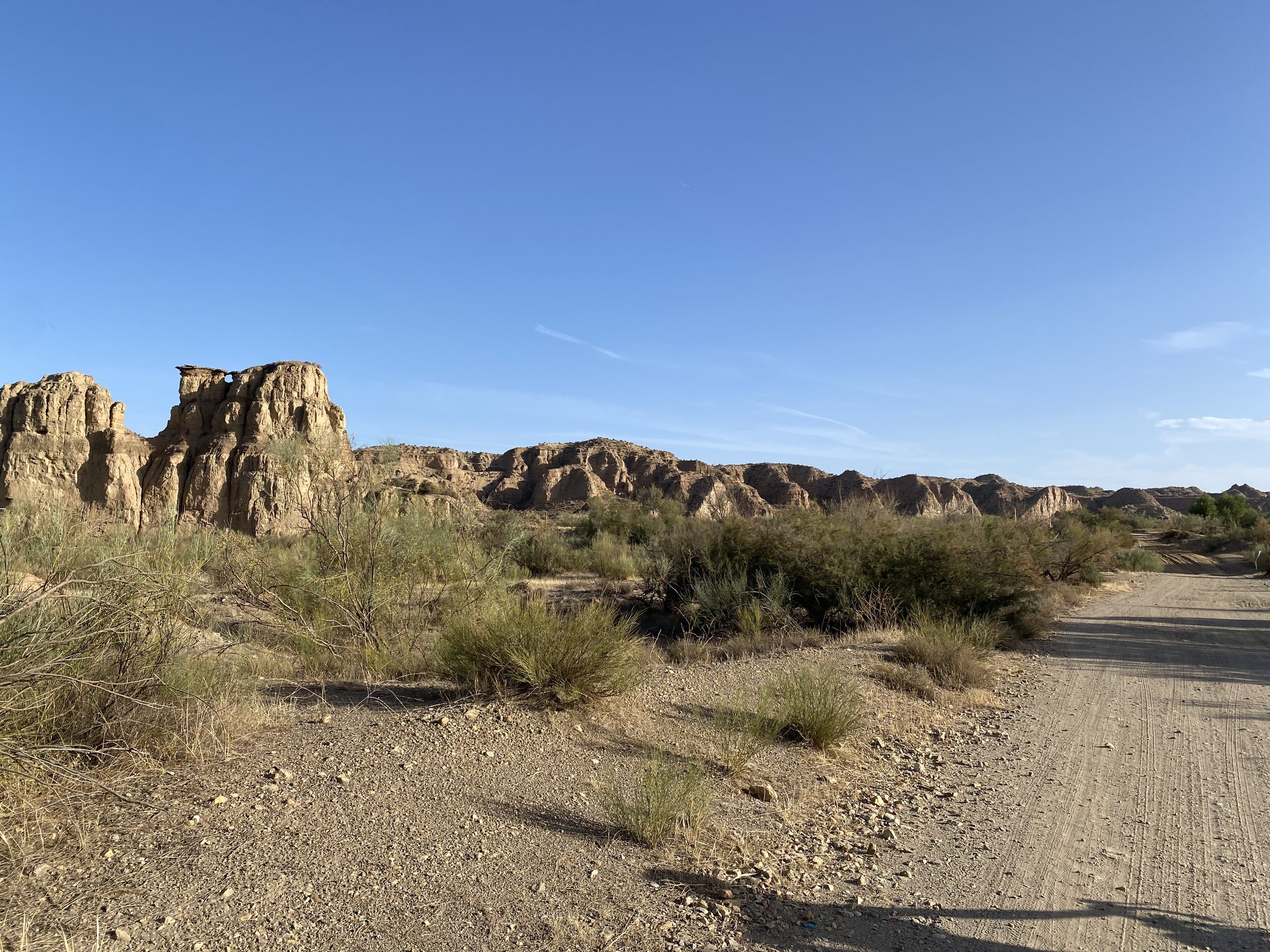
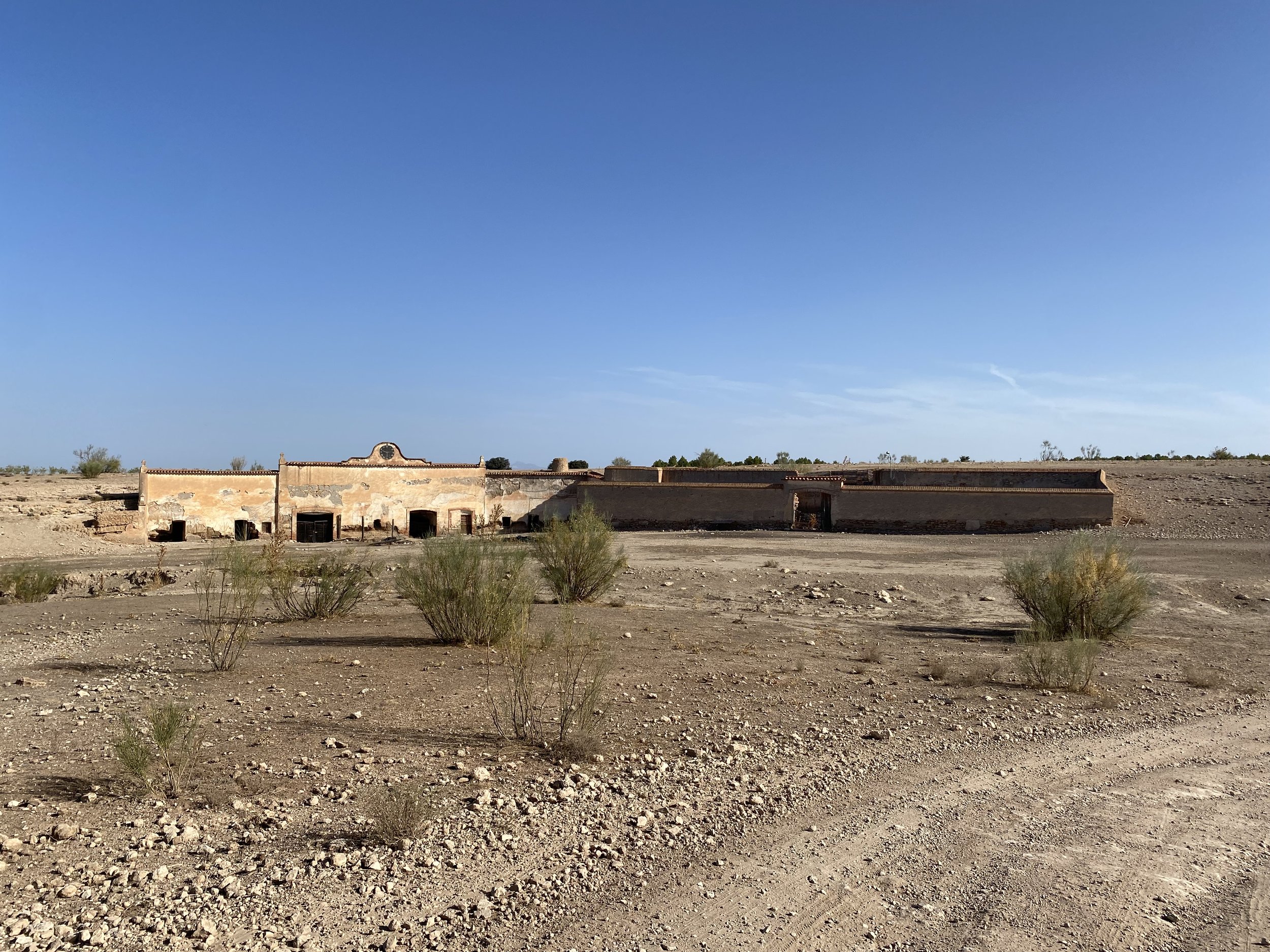
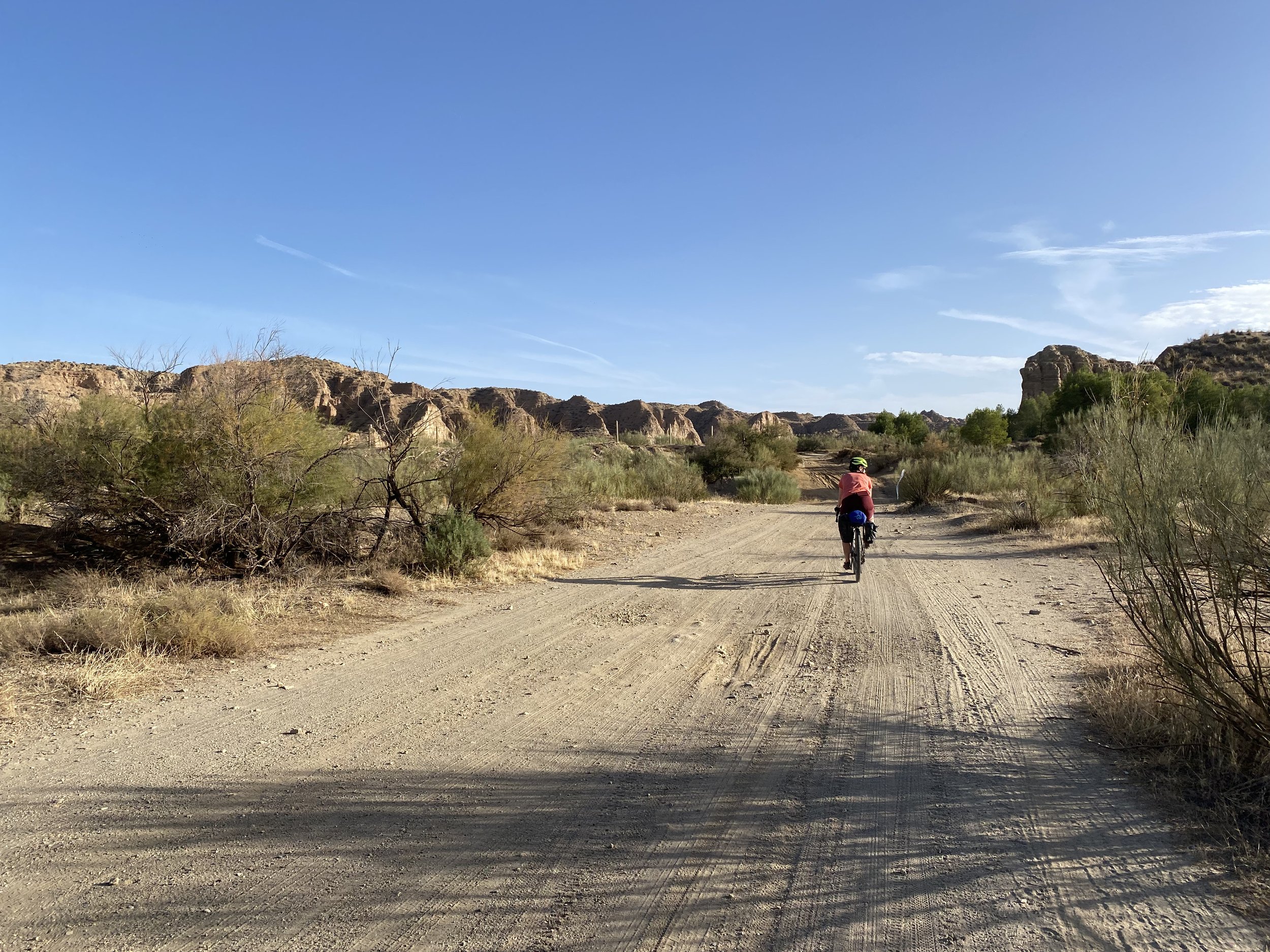
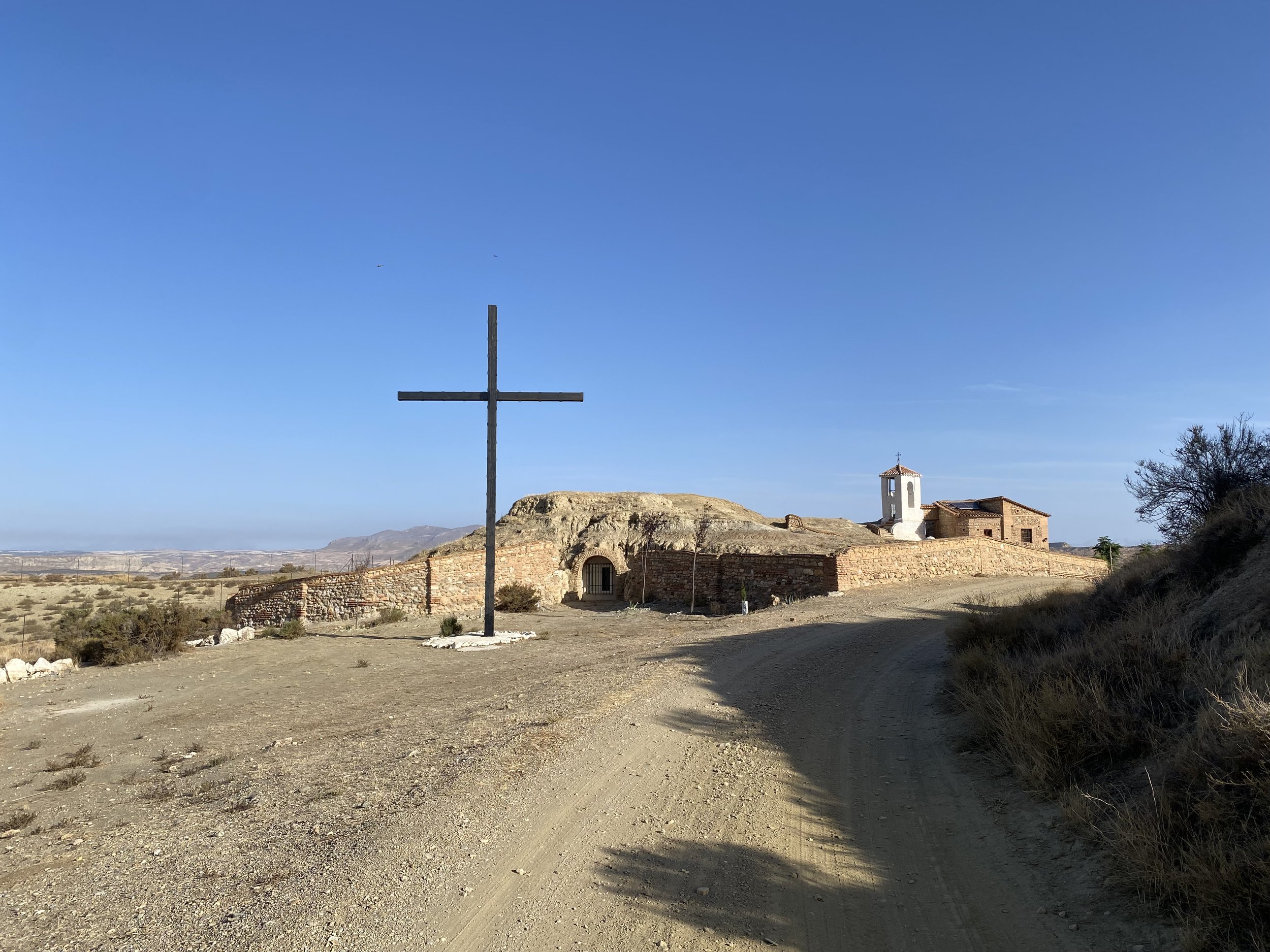
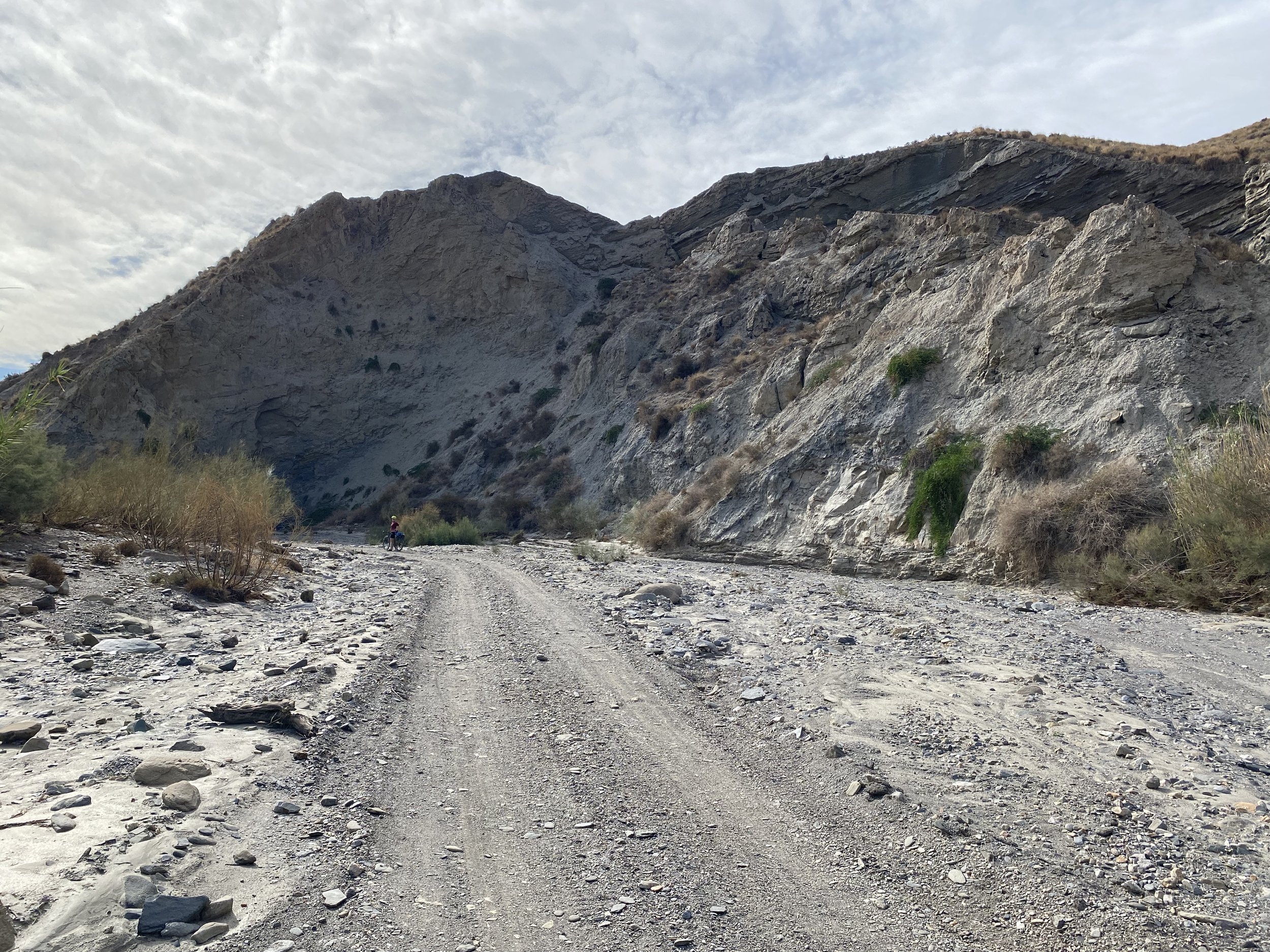
The caves pictured above are some of the oldest human settlements in south-western Europe. They date back to the Neolithic Period, approximately eight thousand years ago. These cave sites, and their remnant artifacts have shed valuable insight on life during the prehistoric period in Spain. The caves are built into limestone cliffs, creating a natural shelter for humans and livestock. However, the arid climate, sparse rainfall, and persistent erosion cumulated into an inhospitable agricultural climate, and the economic consequences forced the settlers to move on decades ago. All that remain are the crumbling shells of what once was someone’s home. We saw them everywhere.
These sedimentary rocks can easily be carved, allowing the creation of a shelter with less construction materials, for far less cost. The cave dwellings provided natural stability against strong desert winds and flash floods, and they were worth getting off your bike for.
The first town we rode through was Gorafe, a quintessential white-washed Spanish town located at the bottom of Gorge Canyon and commonly referred to as the entrance to the Gorafe Desert. We biked into town, hoping to find a coffee and something that resembled real food. No coffee shops, but we managed to find a road-side ice cream stand with the option for either a hot instant coffee or an iced mocha. Thus, breakfast #2 consisted of iced mochas and ice cream sandwiches, a slight but notable improvement over breakfast #1. The popsicle stand was run by a young woman with her toddler. The toddler’s grandfather was also hanging around, along with three of his companions. We were entertained by the local coffee shop culture while we ate and recharged, giggling as the three elderly gentlemen played with the toddler and busted each other’s balls. This was Sunday - go slow, recover, spend time with the people important to you, while playfully remind them why you love them so much. North American culture could take a lesson here. We finished our snack, said “adiós” to the locals, and were immediately impelled forward, climbing the steep cliffs of the Gore Canyon. Entirely worth it for the views.
The ride became increasingly more rugged and beautiful as we progressed towards one of the more popular areas of the Gorafe Desert, Los Coloraos, named for its predominant red colour, reminiscent of the Grand Canyon.
This area is perpetually suffocated with sun exposure, often resulting in temperatures above 40 degrees Celsius. We were there during the fall season, thankfully avoiding the worst of the heat. Every day we rode in a fully exposed 26-28 degree climate. I mostly found the heat tolerable, but at one point mid-afternoon it was too much. I was overheating. Just as I was certainly about to spontaneously combust, a full can of coke appeared, sealed and ripe for the taking in all its caffeinated glory. Was this one of those desert mirages I’ve seen in cartoons? The timing seemed appropriate. I looked at Care Bear. “Would you drink it?” Yes, definitely we would both drink it. Good, we’ll share it then. Care Bear walked over and picked it up. Empty. NOOOOOO! Somehow the Coke was drained from this completely sealed and unpunctured can. Turns out it was a mirage. My overly warm salted water was extra dissatisfying after that.
Another town appeared like an oasis. Desperate for a real meal, Care Bear flagged the only person we saw and attempted to communicate in Spanish. "Ou es manga." Surprisingly, the woman understood this French take on what could potentially be close to Spanish, and directed us to a cafe down the street that was, in fact, OPEN! Success! We each ordered a ham and cheese sandwich (2/9) and a Coke. I don’t think I have ever been more grateful for a meal. As we ate our sandwiches on the patio, across the street from a church, we thanked Jesus for allowing this single, tiny, desert-town restaurant to remain open on a Sunday. I ate hastily. There was a small group of locals lounging around, embracing the Sunday culture. We chatted with them about where we had come from, where we were headed, and yes, it was challenging to be biking in this heat. It was unpleasantly hot. Between the heat, and a now full belly, fatigue hit me like a ton of bricks. Care Bear chooses to chew her food, so I was, as usual, finished eating way before her. Perfect, I’m having a nap, and managed to sleep for 12 minutes on the table while Care Bear finished her lunch. Chewing, such a waste of time.
The next 30km promised at least two hours of solid climbing. It was 2pm, unsettlingly hot, and steadily getting hotter. We climbed two 22% inclines on livestock paths, but thankfully the conditions were firm and dry. This would be a nightmare if it were raining. Otherwise, we were mostly in good spirits.
The road got progressively better as we climbed along some beautiful sandy dunes, seeing vegetation that we had not yet encountered. We were surprised to see the microclimates change so quickly in the desert. The vegetation’s biodiversity was remarkable given such harsh conditions.
With two days of climbing well underway, we both started to develop mantras to help deal with the mental anguish of climbing. Care Bear adopted a method she learned from Coach L’Espy’s wife, Haley Smith, a talented and well decorated professional off road cyclist, previously representing Canada in the olympics for mountain biking. She is truly an inspiration to female riders of all ages. Haley suggests the very useful tactic of focusing on a body part that doesn’t hurt when suffering on a long climb or race. Care Bear often choses to focus on her ears. I couldn’t comply with something quite so congenial. I biased towards leaning into the hurt, and I adopted the slightly annoying tactic of digging in with a mantra from The Moffatt’s 1999 hit single “Misery.” (I know, I’m dating myself here. I don’t care).
The climb ended at a dam across a deep river bed with the tiniest stream at its base. The escarpment consisted of unstable dirt which looked highly susceptible to erosion. It would have been an engineering feat to create a structure that can contain the force of water against this crumbling landscape. However, watching the little stream below us run (run seems too generous a term for what this water was doing, it was a slow jog at best), it was hard to imagine the stream creating enough force to carve the canyon we were crossing, let alone warranting the effort of building a dam to harnessing it’s power, yet here it was.
In a way, this long climb wasn’t as hard as yesterday’s undertaking. It felt way hotter, and that was terrible. But besides a couple of short, rugged hike-a-bike sections, the climb was gradual and the road was in good shape. As with everything else in life, the climb eventually ended. We started a long, glorious descent. The scenery was epic.
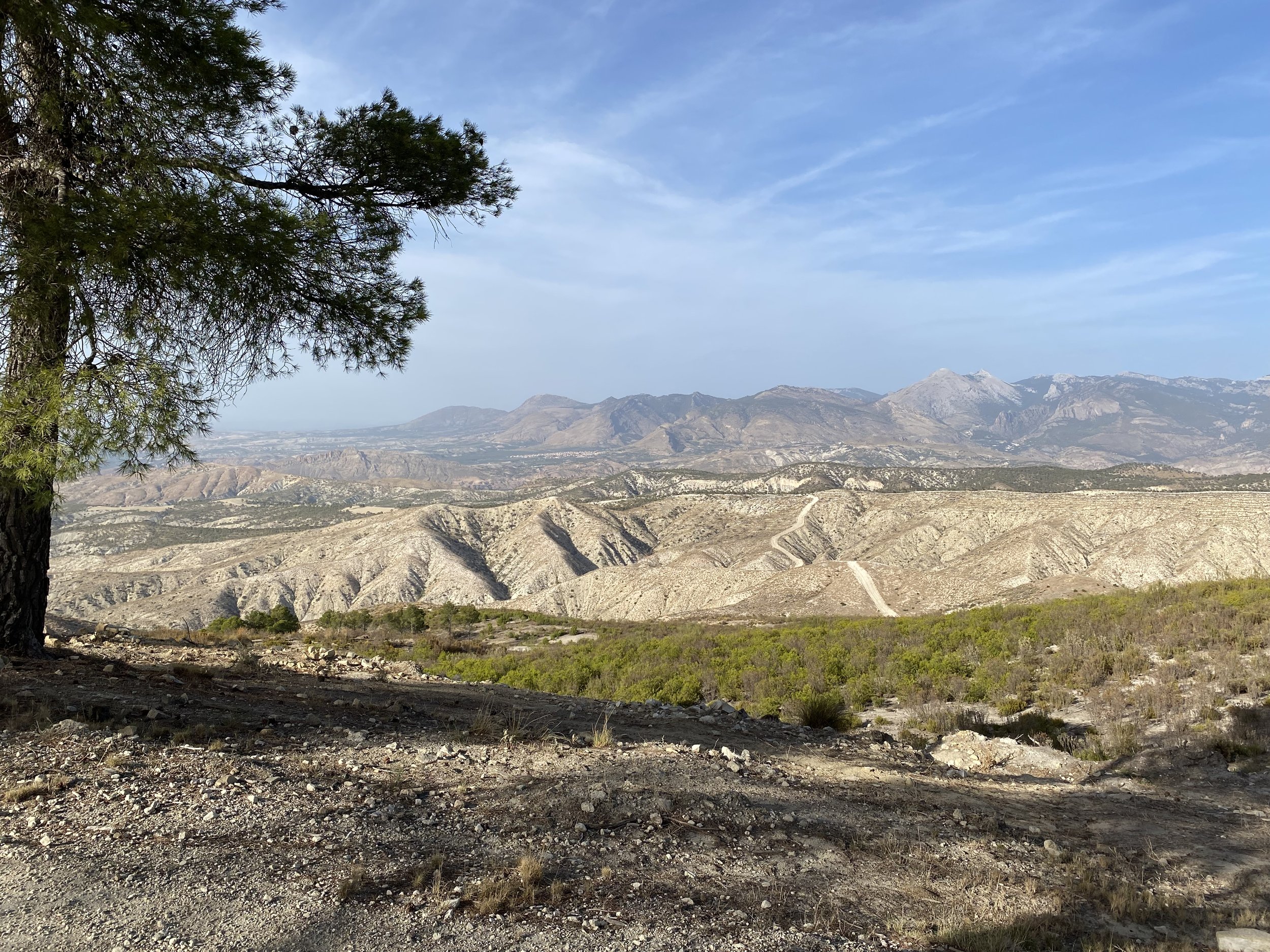
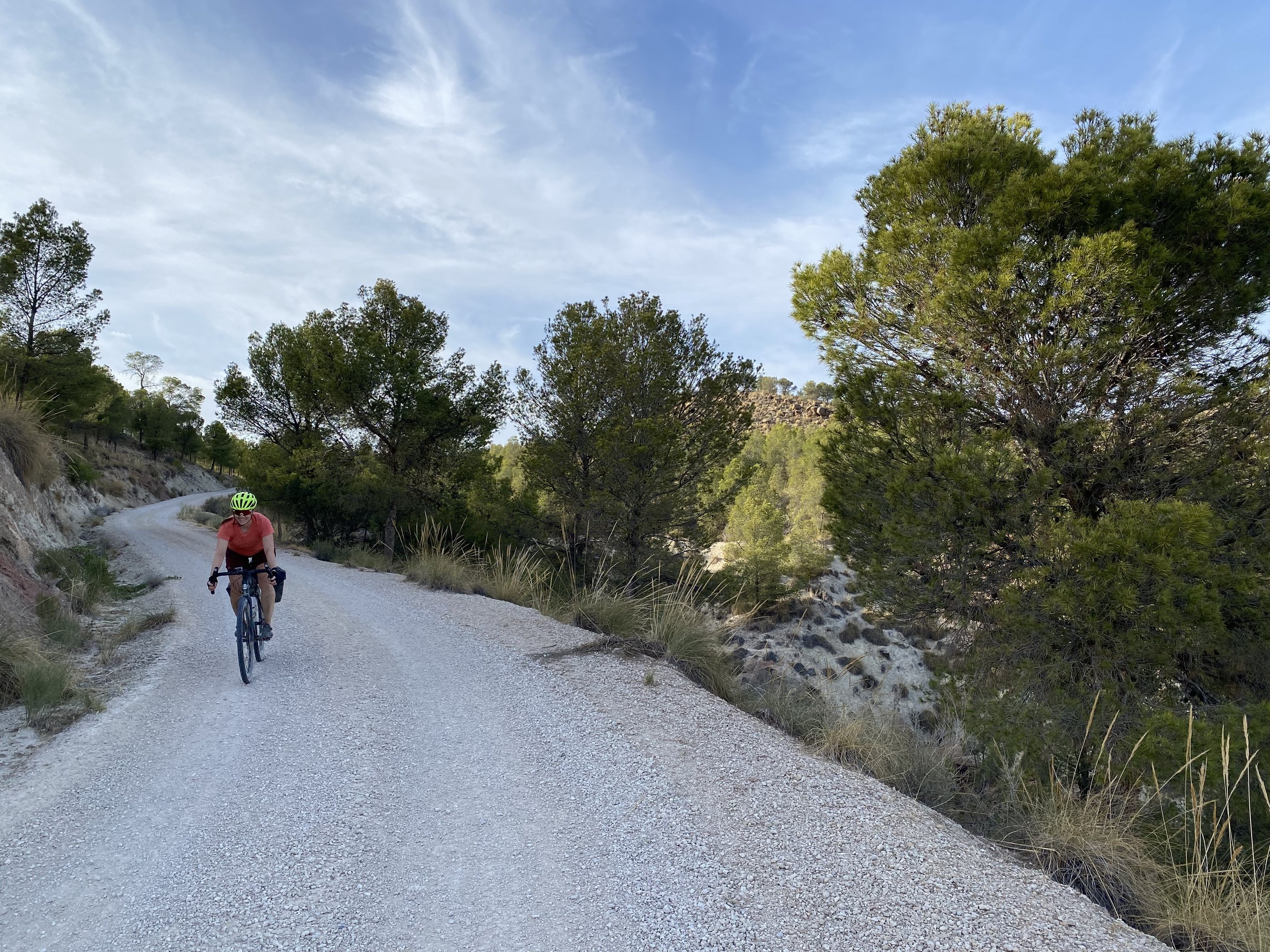
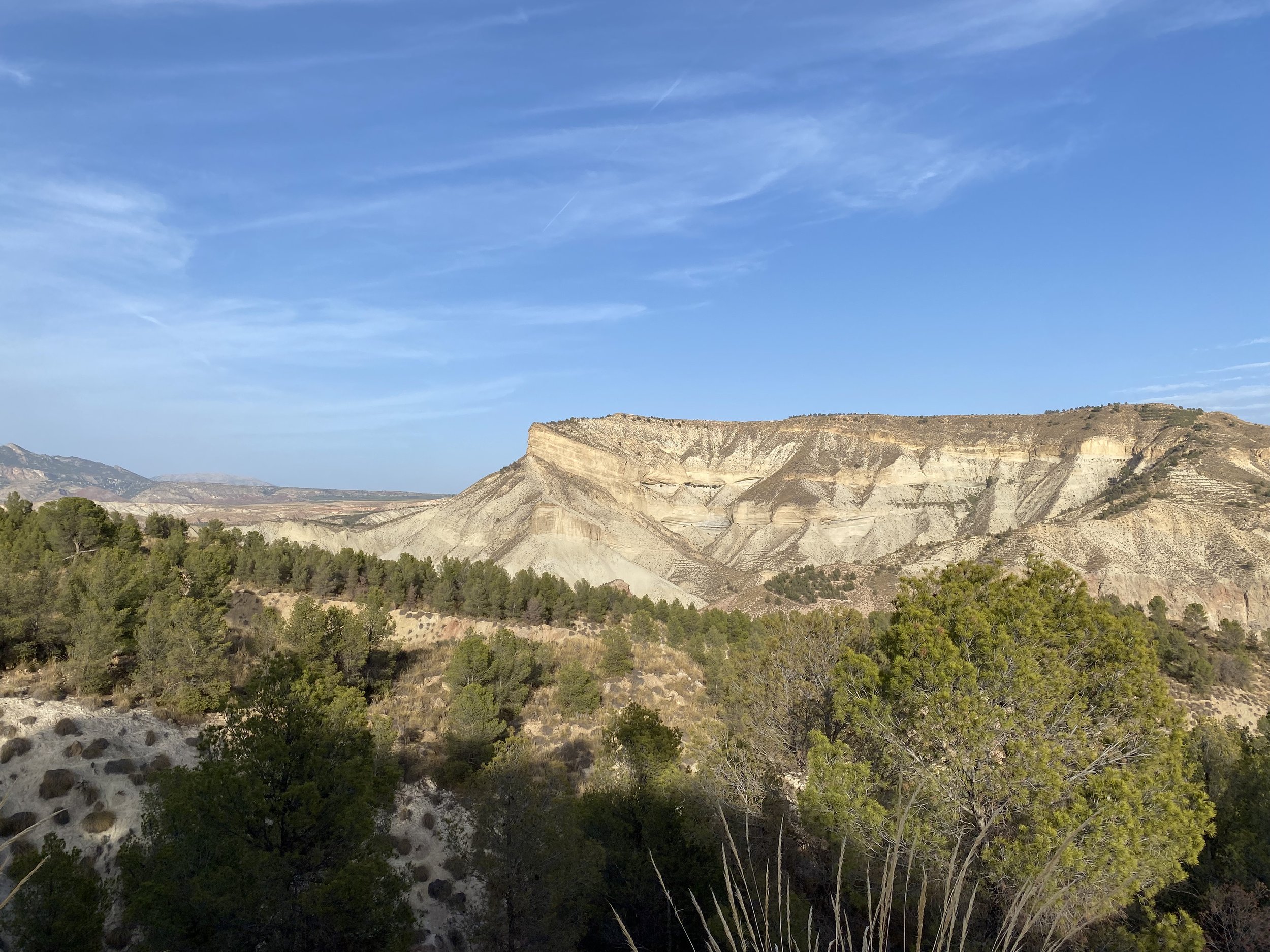
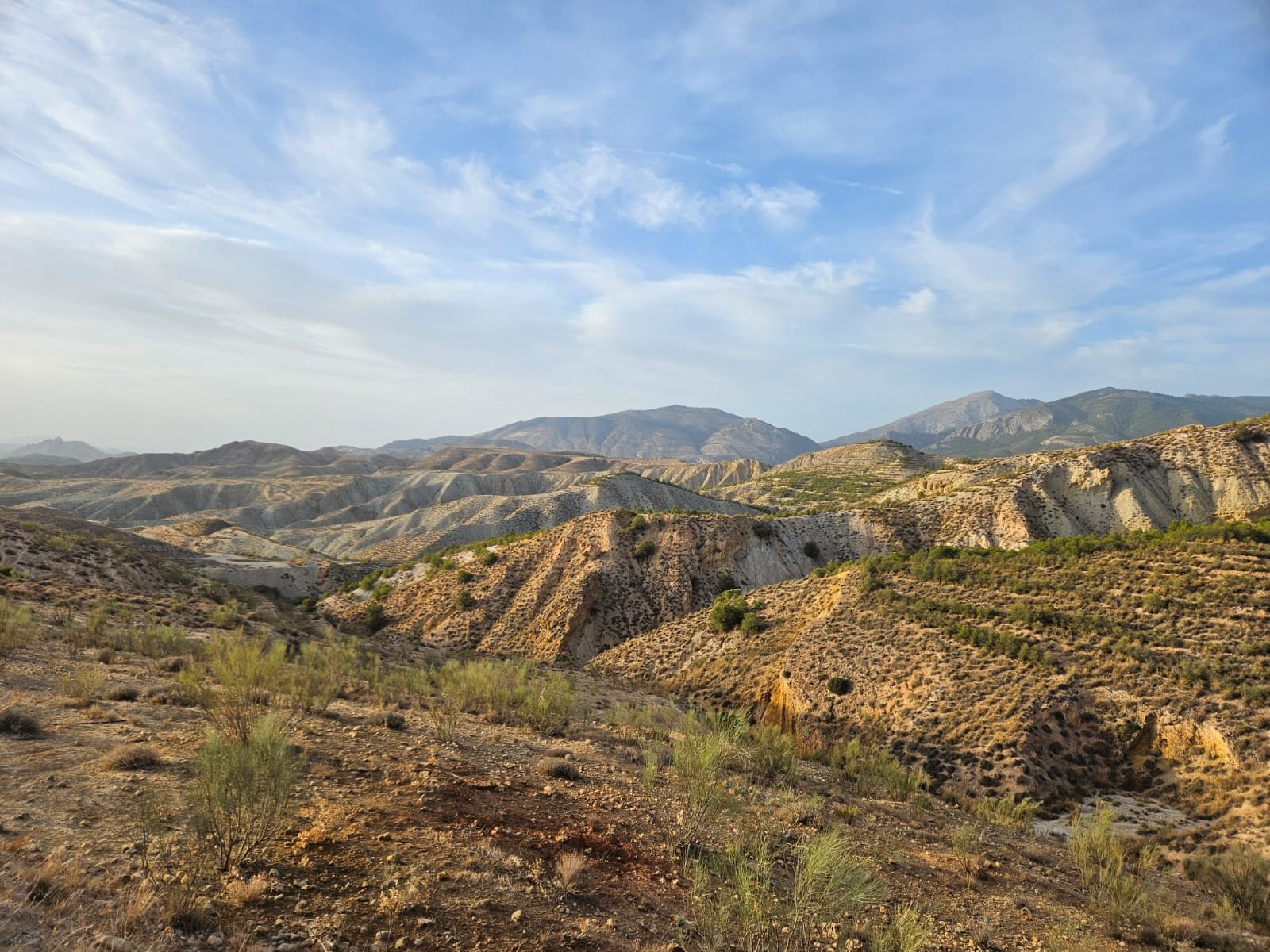
The descent finished at the most opulent olive farm, aptly placed in shadows of a grandiose mountain range, with a lovely little turquoise stream running by.
Then, as if to ensure we weren’t enjoying ourselves too much, we climbed out of said beautiful farmland. It was steep and difficult, and Care Bear had fallen behind on her fuelling. She was unhappy about this climb, so it was my turn to document the fun.
We climbed the cliffs just as the sun was starting to fall low in the sky. Time for one final push to our destination.
Finally, we came across this sighting. Yeah! Giant plate of tomatoes here I come!
Honestly, this town is situated in the most beautiful valley, so we were greeted with one more incredible lookout before we dropped into town, checked into our hotel, and were once again handed the keys to the front door.
We ate dinner at the town’s tiny restaurant, soaking in the last of the Sunday cafe culture, moving slowly and enjoying time together before we stretched by the pool and finished our day with an unaccompanied nighttime swim under the stars, but not before we almost locked ourselves out of the hotel for the night.
Today’s shoutout goes to Coach L’Espy for preparing us both mentally and physically for this journey. He had his work cut out for him considering that I spent most of the summer rehabbing from one crash or another, but today we were most grateful for how he taught us to persevere. In every event, race, or ride there will be unavoidable moments of anguish. The suffering inevitably ends, but if you persevere, you will be rewarded with the euphoria of having done so.
Nerdy bikepacking details for the day:
Actual ride: 110km and 2057m, 1.5km and 195m elevation more than initially predicted (thanks for that RWGPS, I could have done without that last 200m elevation).
Some info on our wheel setup. We both ride pretty aggressive cyclocross bikes, with clearance for 40c x700 tires. We wanted to bring our own bikes to Spain rather than rent for a couple of reasons. The most important being our bikes have been custom fit to our bodies by James Van Trover the physio bike fitter at Active Health Hintonburg. Bike fit is an interesting art and bike fitters make adjustments in milimeters. Small adjustments make a huge difference to efficiency and injury prevention, both completely necessary on these long days in the saddle, so we felt it essential to have this nailed. The only way to guarantee the fit was to bring our own bikes. This had the added bonus of ensuring we knew the bikes, had the appropriate spare parts, and could confirm they were in good working order before we left.
We were lucky enough to touch base with Rob Britton, winner of the 2023 Badlands race with an unfathomable time of 1 day 14 hours, 20 mins. Honestly, having rode most of it, that seems impossible. I’m quite certain this man is omnipotent. He suggested we use 40c tires with foam inserts as a minimum (foam inserts allow you to use lower tire pressures without risking a pinch flat, they are also super nice to ride, but are hard to work with if you ended up having to change the rubber or throw in a tube on the fly). We both invested in some fancy-pants carbon rims to stiffen up the responsiveness of the handling and drop some weight. Between the rims and the inserts, this is a really nice set up to ride, and a hard to achieve combination of being both smooth and agile. We also put on a 42T cassette for the long climbs (we both ride 2x set ups and my small chain ring upfront is 30T, so the 30x42 was super appreciated for all the climbing with all the gear). I love this set up, but honestly the terrain was extremely rough for long sections of road, like trying to ride a dried up coral reef. It was rough, slow, and frustrating, and during those times I wish I had 50c tires. These sections weren’t infrequent, but we managed.
Other Travel Blogs:

